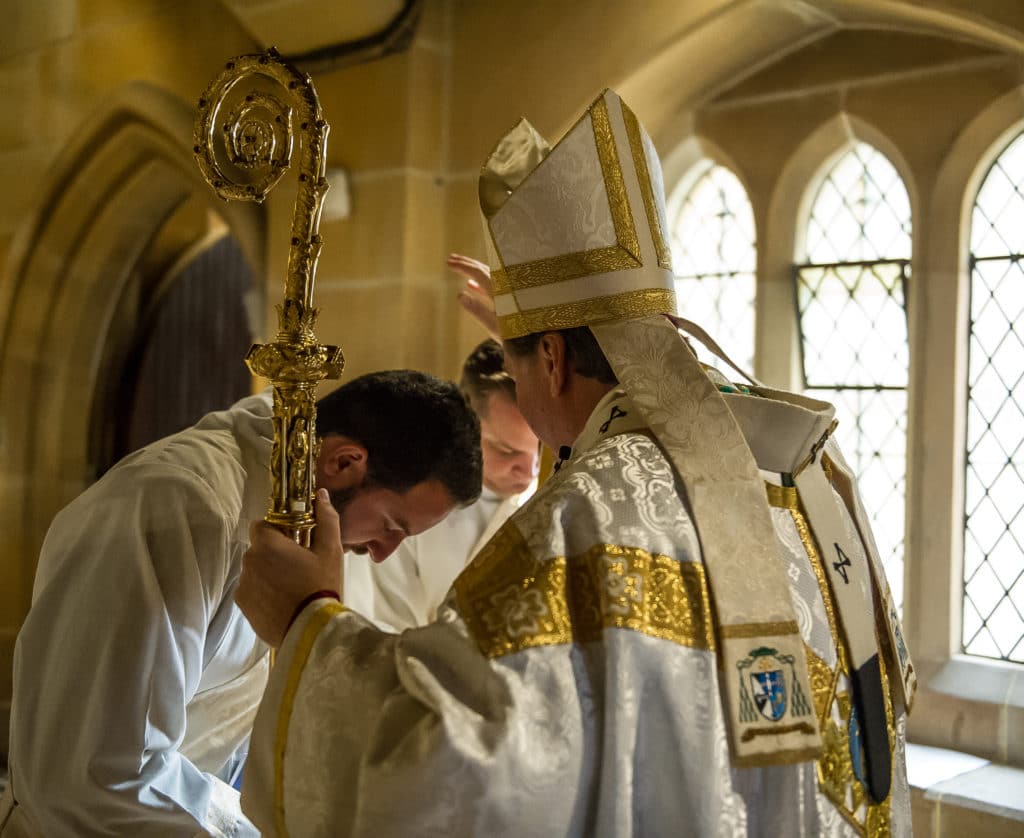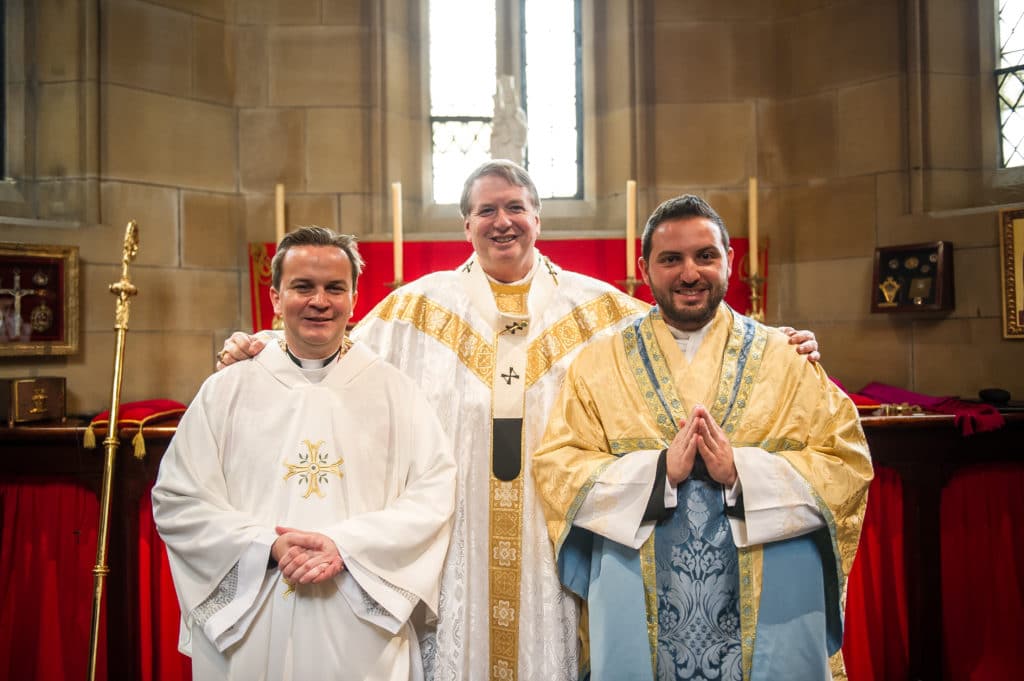From today, Archbishop Fisher tells new priests, ‘you will participate in Christ’s power to build up God’s Kingdom in Sydney through word and sacrament … through you, those hungry for truth will be fed, those thirsty for consolation, inspired, and those needing grace, restored’
The low-budget Christian horror-film Final: The Rapture was released late last year. Directed by Timothy Chey, it details the global chaos after all the best people are raptured up to heaven – as some evangelical Christians believe will happen – and follows the stories of four of those left behind.
Professional footballer Colin Nelson (played by Jah Shams) is one left stranded when his good Christian wife is assumed into heaven (she’s played, appropriately enough, by an actress named Mary Grace).

The movie is described in the advertising bumf as “breathtaking, gripping, layered and astonishing … it will captivate you from the very first minute to the stunning, tear-jerking end.”
I’m not so sure. But the film does join a long and rich genre of end-of-the-world and post-apocalypse cinema – whether coming from the spiritual heavens (as in Legion or Noah) or the astronomical heavens (such as Deep Impact and Armageddon) or the alien heavens (as in War of the Worlds and Battle Los Angeles). Other apocalypses begin here on earth at the hands of natural phenomena (Supervolcano, Contagion) or technology (as in the Terminator and Matrix series) or zombies (28 Days, Evil Dead) or nuclear or biological weapons (Resident Evil and Mad Max). One way or another, events around the end of time are endlessly fascinating for human beings.
Our first reading today comes from a book of Scripture which has generated much of this strain of apocalypticism in Western culture: the Book of Revelation by St John the Divine (Rev 11:19, 12:1-10). It’s a mysterious work, alien to our technocratic, historicist, secular mindset that usually excludes the transcendent. It was read at my installation as archbishop and one of the politicians present asked me why on earth such a strange thing would be read!
Though alien and confronting, such Scripture may still resonate with a culture that has replaced fear of a spiritual apocalypse with fear of a nuclear one, then with fear of various pandemics, and most recently with anxiety about a climate apocalypse, a culture that still likes stories of good versus evil, speculations about the future, and the possibility that there is more to this world than the things science and history measure, report and control.
Yet unlike the dark movie apocalyptic, the Christian version is full of hope: hope for a Saviour child, for a Mother and a God who will keep Him safe, for life beyond the tomb, for a merciful judgment that will vindicate the oppressed, for salvation from the heavens. St Paul’s version in our epistle today is less florid than St John’s, but it, too, foresees a general resurrection when Christ the first-born from the dead will raise up His faithful, not for some sort of zombie apocalypse, but to a kingdom of truth, justice and peace, a new Eden in which death has been conquered forever (1 Cor 15:20-26).
For all Paul’s encouraging words, we might still wonder whether that resurrection is just sci-fi fantasy or wishful thinking. For God-made-man it was straightforward enough to live beyond the tomb: but for us mere mortals? Today’s feast is the answer to that anxiety: it is the feast of divine reassurance, reassurance of our resurrection.
As we witness the Assumption into heaven of the Woman of the Apocalypse, the pre-emptively gifted Immaculate Mother, the real Mary Grace, we witness rapture not just for a single favourite of God or for a predestined elite, but the trajectory to a heaven to which we all are called.
That same Mary Grace magnifies the merciful Lord in our Gospel today, singing of the One who casts the mighty from their thrones and raises up the lowly – raises them up all the way to heaven! (Lk 1:39-56) Mary’s version of the end of time is something to welcome: that time when our bodies will be glorified, our spirits exalted, our whole being in company with God and His saints.
Dear sons and brothers in Christ, Thomas and Lewi, it is to such a Marian future – and not the far less satisfactory futures of human fantasy, ambition or neglect – that you must lead and goad us in the years ahead. Like the Virgin in her Magnificat your souls will proclaim the marvels God has worked for us.
Like that Virgin Assumed into heaven, you will join the angels and saints serving at God’s altar, eventually we hope in heaven but first here on earth. Pope Francis, in his recent encyclical, Laudato Si’, cites our first reading in addressing Mary as “Queen of All Creation”.
As she now “grieves for the sufferings of the crucified poor and for the creatures of this world laid waste by human power”, she is a cause of hope for all material creation, for “in her glorified body, together with the Risen Christ, part of creation has reached the fullness of its beauty”.
That transfiguration, to which we all look forward, is prefigured in every Eucharist. For there, as the Pope explains, all material creation “finds its greatest exaltation” as ordinary bread and wine become the substance of God given for us. This Eucharist, he explains, “is the living centre of the universe, the overflowing core of love and of inexhaustible life. Joined to the incarnate Son, present in the Eucharist, the whole cosmos gives thanks to God”.
Earth is joined to heaven and “the world which came forth from God’s hands returns to him in blessed and undivided adoration”. Even when celebrated by the humblest priest on the humblest altar, it is “always in some way celebrated on the altar of the world”.
This is your task, my dear sons and brothers, from this day forward. From today, you will participate in Christ’s power to build up God’s Kingdom in Sydney through word and sacrament. Through you, babies will be transformed into children of God and sinners into saints. Through you, those hungry for truth will be fed, those thirsty for consolation, inspired, and those needing grace, restored. Through you, bread and wine will be transformed into Christ’s flesh for the life of the world.
Through you, couples will be united in the sacred bond of matrimony, the sick raised to healing and hope, the dead consigned to divine mercy. Through you God’s People will be sanctified and taught, led and encouraged in their turn to be the “priests, prophets and kings” Christ calls all His own to be. Only then can the Church appear like our Blessed Mother, as a shining light in the heavens, a Mother promising a bright future for hurting humanity.
Tom Stevens’ journey to seminary and priesthood is a tale of a growing certitude and repeated “putting it off”. Like his bishop, he was born in the Mater, blessed with an excellent Catholic education (though on the other side of the river) and studied law. I’ve often said we all have shameful things in our past and one of mine is that I was a lawyer.

Well, Tom took even longer to repent but finally crossed over from the courts of law to the courts of our God. His faith and vocation were nurtured by his mother Robyn and father Ron, his diocesan-priest uncle and the Marists who schooled him and with whom he worked. Like Lewi he had the advantage of seminaries both in Sydney and Rome and pastoral experiences that confirmed for him and for me his suitability for priestly service.
Lewi, a youngest child like Tom, is of Syrian background. We are especially conscious of the suffering of Syrian Christians at this time, at the hands of the evil IS organisation and others, the daily martyrdoms, exile and other torments. That a beautiful Syrian-Australian heart is being offered today for priesthood can only be a cause of hope and healing for these suffering people. Lewi studied and practised as a fitness professional rather than a legal one, and so has less to repent of. While serving the Church of Sydney and youth of the world at World Youth Day 2008 he discerned God’s will for him. There are many answers one might give those who wonder whether World Youth Day is worth all the bother: one will lie in our sanctuary today.
My dear sons, Tom and Lewi, from today God’s people invite you to share in the most crucial points of their lives: their births, marriages and deaths, their sins and aspirations, their hunger for truth and love, their moments of touching the divine but also of desolation. Subject to your bishop and united to your new brothers in the priesthood, strive to bring the faithful together into one family. May your ministry, like the rapture film, be “breathtaking, gripping, layered and astonishing, captivating you from the very first minute to the stunning, tear-jerking end”.
As we delight in these two new priests for the archdiocese of Sydney we are all too aware of our need and so pray that the Lord of the harvest will send us many more. I ask all those present to consider how they might help promote vocations by prayer, personal discernment, encouraging others to put up their hand and supporting those already in the priesthood or seminary.
This is the edited text of the homily by Archbishop Anthony Fisher OP for the Solemnity of the Assumption and the ordinations to the priesthood of deacons Lewi Barakat and Thomas Stevens at St Mary’s Cathedral, Sydney, on 15 August.
